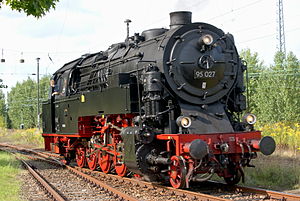- Prussian T 20
-
Prussian T 20
DRG Class 95
DR Class 95.0/1Number(s): DRG 95 001–045 Quantity: 45 Manufacturer: Borsig, Hanomag Year(s) of manufacture: 1922–1924 Retired: 1978 Axle arrangement: 1'E1' h2t Type: Gt 57.19 Gauge: 1,435 mm Length over buffers: 15,100 mm Height: 4,550 mm Overall wheelbase: 11,900 mm Empty weight: 103.7 t Service weight: 127.4 t Adhesive weight: 95.3 t Axle load: 19.1 t Top speed: 70 km/h Indicated Power: 1,192 kW Driving wheel diameter: 1,400 mm Leading wheel diameter: 850 mm Trailing wheel diameter: 850 mm No. of cylinders: 2 Cylinder bore: 700 mm Piston stroke: 660 mm Boiler Overpressure: 14 bar Grate area: 4.36 m² Superheater area: 62.50 m² Evaporative heating area: 200.00 m² Water capacity: 12.0 m³ Fuel: 4 t coal Brakes: Knorr compressed-air brake
Riggenbach counter-pressure brakeThe German DRG Class 95 was a ten-coupled tank locomotive with a 2-10-2 wheel arrangement, which was procured by the Deutsche Reichsbahn (also referred to later as the Deutsche Reichsbahn-Gesellschaft or DRG) in 1922 for hauling heavy goods trains on steep main lines. Because the development of this class was begun by the Prussian state railways, it was designated as the Prussian Class T 20.
Contents
History
The first ten locomotives, built in 1922, were ordered as T 20 Magdeburg 9201–9210 and, because they were at first intended to be grouped into Class 77, were supplied as numbers 77 001 to 77 010. By 1923 they had been renumbered to 95 001–010. A total of 45 locomotives were built by 1924. Their areas of operations included the Sonneberg–Probstzella line, the Spessart ramp, the Franconian Forest Railway, the Geislingen ramp (Geislinger Steige), the Schiefe Ebene and the Rübeland Railway, where they earned their nickname Bergkönigin ('mountain queen').
The locomotives were the most powerful tank engines procured by the DRG. They could haul a train load of 2060 tonnes at a speed of 50 km/h on the flat and could still manage 430 tonnes at 25 km/h on a 25‰ incline. The very high traction load of 95.3 tonnes enabled it to cope with inclines of up to 70‰ without needing a rack and its Riggenbach counter-pressure brake ensured that it could brake even heavy loads on a downhill stretch.
Of the 45 examples owned by the Reichsbahn, the Deutsche Bundesbahn took over 14 that, towards the end, were stationed in Aschaffenburg and used as pusher locomotives on the Spessart ramp. They were retired in 1958. Locomotives had also been stabled in Neuenmarkt-Wirsberg until 1952 for duties on the Schiefe Ebene.
31 locomotives ended up in the East German Deutsche Reichsbahn. Of these, 24 were rebuilt to oil-firing between 1971 and 1973 and ten were given a newly-designed boiler. From 1970 the oil-fired engines were designated as DR Class 95.0 and the unconverted ones as DR Class 95.1. The last locomotives worked the line from Sonneberg toEisfeld and were retired in 1981.
Preserved Locomotives
The following locomotives have been preserved:
- 95 027 restored and operating on the Rübeland Railway (as of 27 Nov 2010)
- 95 009 (photo above left) at Dieringhausen Railway Museum
- 95 028 in the Bochum-Dahlhausen Railway Museum
- 95 016 (ex Kamenz locomotive depot) in the German Steam Locomotive Museum at Neuenmarkt-Wirsberg.
- 95 020 on display at the Technikmuseum Speyer.
At present only 95 027 is operational.
See also
- Prussian state railways
- List of DRG locomotives and railbuses
- List of Prussian locomotives and railbuses
Sources
- Wolfgang Brozeit, Hans Müller, Günter Bölke: Baureihe 95: Der Lebenslauf der "Bergkönigin". transpress Verlagsgesellschaft, Berlin 1990 (1. Aufl.) und 1994 (2. Aufl.), ISBN 3-344-00377-1.
- Harald Vogelsang: Die Fahrzeuge und Anlagen des Eisenbahnmuseums Bochum-Dahlhausen, ISBN 3-921700-99-X
External links
- Bilder der Baureihe 95
- There is a relevant English-language forum at Railways of Germany
Classes of Prussian locomotive Express train locomotives 
Passenger and express train locomotives Goods train locomotives Tank locomotives T 0 · T 1 · T 2 · T 2/T 4 · T 2.1 · T 2/T 3/T 4 · T 3 · T 4 · T 4.1 · T 4.2 · T 4.3 · T 5.1 · T 5.2 · T 6 · T 7 · T 8 · T 9 Elberfeld · T 9 Langenschwalbach · T 9.1 · T 9.2 · T 9.3 · T 10 · T 11 · T 12 · T 13 Hagans · T 13.1 · T 14 · T 14.1 · T 14 (Exp.) · T 15 · T 16 (Exp.) · T 16 · T 16.1 · T 18 · T 20 · T 26 · T 28Narrow gauge locomotives Electric locomotives to followRailbuses to followCategories:- 2-10-2T locomotives
- Locomotives of Prussia
- Borsig locomotives
- Hanomag locomotives
Wikimedia Foundation. 2010.

